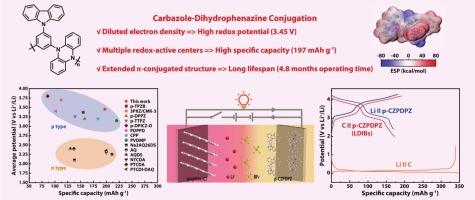新一代锂双离子电池用卡巴唑-二氢非那嗪偶联的高压有机阴极
IF 22
1区 材料科学
Q1 MATERIALS SCIENCE, MULTIDISCIPLINARY
引用次数: 0
摘要
有机氧化还原活性化合物在推进电池技术方面显示出巨大的潜力,但传统的有机阴极仍然存在容量低和输出电压不足的问题。本文设计了一种基于聚[5-(3-(9h -咔唑-9-基)苯基)-5,10-二氢非那嗪](p-CZPDPZ)的p型有机聚合物阴极,其中咔唑(CZ)和二氢非那嗪(DPZ)通过Buchwald-Hartwig C-N交叉偶联反应偶联,平均电位为3.45 V,峰值比容量为197mAh g - 1,能量密度为680 Wh kg - 1。p-CZPDPZ的扩展π共轭结构在氧化还原过程中通过全骨架离域实现了有效的电子密度稀释和单电子稳定,有助于4.8个月的超长寿命和超过1600次的长期循环稳定性。表征和理论计算证实了p-CZPDPZ能够稳定可逆地储存BF4-用于电荷补偿。用石墨阳极和p-CZPDPZ阴极组装的锂基双离子电池(LDIBs)具有185 mAh g−1的峰值放电容量和高达596 Wh kg−1的能量密度,循环次数超过1400次。该研究为通过分子偶联策略设计高性能有机正极材料提供了一个新的框架,为推进下一代锂双离子电池提供了巨大的潜力。本文章由计算机程序翻译,如有差异,请以英文原文为准。

Unveiling high-voltage organic cathodes via carbazole-dihydrophenazine conjugation for next-generation lithium dual-ion batteries
Organic redox-active compounds have shown immense potential in advancing battery technology, yet conventional organic cathodes still struggle with low capacities and insufficient output voltages. Here, we design a p-type organic polymer cathode based on poly[5-(3-(9H-carbazol-9-yl)phenyl)-5,10-dihydrophenazine] (p-CZPDPZ), in which the conjugation of carbazole (CZ) and dihydrophenazine (DPZ) units through Buchwald-Hartwig C-N cross-coupling reaction leads to a remarkable average potential of 3.45 V, a peak specific capacity of 197mAh g−1, and an impressive energy density of 680 Wh kg−1. The expanded π-conjugated architecture in p-CZPDPZ enables efficient electron density dilution and single-electron stabilization through whole-skeleton delocalization during redox processes, contributing to an exceptional lifespan of 4.8 months with a long-term cycling stability exceeding 1600 cycles. Characterizations and theoretical calculations confirm that p-CZPDPZ can stably and reversibly store BF4- for charge compensation. The constructed Li-based dual-ion full batteries (LDIBs) assembled with graphite anode and p-CZPDPZ cathode exhibit a peak discharge capacity of 185 mAh g−1 and an energy density of up to 596 Wh kg−1 with over 1400 cycles. This study provides a novel framework for designing high-performance organic cathode materials through molecular conjugation strategy, offering substantial potential for advancing next-generation lithium dual-ion batteries.
求助全文
通过发布文献求助,成功后即可免费获取论文全文。
去求助
来源期刊

Materials Today
工程技术-材料科学:综合
CiteScore
36.30
自引率
1.20%
发文量
237
审稿时长
23 days
期刊介绍:
Materials Today is the leading journal in the Materials Today family, focusing on the latest and most impactful work in the materials science community. With a reputation for excellence in news and reviews, the journal has now expanded its coverage to include original research and aims to be at the forefront of the field.
We welcome comprehensive articles, short communications, and review articles from established leaders in the rapidly evolving fields of materials science and related disciplines. We strive to provide authors with rigorous peer review, fast publication, and maximum exposure for their work. While we only accept the most significant manuscripts, our speedy evaluation process ensures that there are no unnecessary publication delays.
 求助内容:
求助内容: 应助结果提醒方式:
应助结果提醒方式:


